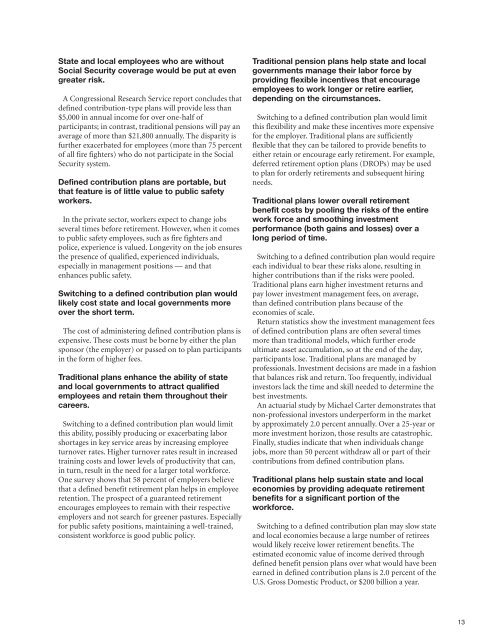Pension Handbook - International Association of Fire Fighters
Pension Handbook - International Association of Fire Fighters
Pension Handbook - International Association of Fire Fighters
Create successful ePaper yourself
Turn your PDF publications into a flip-book with our unique Google optimized e-Paper software.
State and local employees who are without<br />
Social Security coverage would be put at even<br />
greater risk.<br />
A Congressional Research Service report concludes that<br />
defined contribution-type plans will provide less than<br />
$5,000 in annual income for over one-half <strong>of</strong><br />
participants; in contrast, traditional pensions will pay an<br />
average <strong>of</strong> more than $21,800 annually. The disparity is<br />
further exacerbated for employees (more than 75 percent<br />
<strong>of</strong> all fire fighters) who do not participate in the Social<br />
Security system.<br />
Defined contribution plans are portable, but<br />
that feature is <strong>of</strong> little value to public safety<br />
workers.<br />
In the private sector, workers expect to change jobs<br />
several times before retirement. However, when it comes<br />
to public safety employees, such as fire fighters and<br />
police, experience is valued. Longevity on the job ensures<br />
the presence <strong>of</strong> qualified, experienced individuals,<br />
especially in management positions — and that<br />
enhances public safety.<br />
Switching to a defined contribution plan would<br />
likely cost state and local governments more<br />
over the short term.<br />
The cost <strong>of</strong> administering defined contribution plans is<br />
expensive. These costs must be borne by either the plan<br />
sponsor (the employer) or passed on to plan participants<br />
in the form <strong>of</strong> higher fees.<br />
Traditional plans enhance the ability <strong>of</strong> state<br />
and local governments to attract qualified<br />
employees and retain them throughout their<br />
careers.<br />
Switching to a defined contribution plan would limit<br />
this ability, possibly producing or exacerbating labor<br />
shortages in key service areas by increasing employee<br />
turnover rates. Higher turnover rates result in increased<br />
training costs and lower levels <strong>of</strong> productivity that can,<br />
in turn, result in the need for a larger total workforce.<br />
One survey shows that 58 percent <strong>of</strong> employers believe<br />
that a defined benefit retirement plan helps in employee<br />
retention. The prospect <strong>of</strong> a guaranteed retirement<br />
encourages employees to remain with their respective<br />
employers and not search for greener pastures. Especially<br />
for public safety positions, maintaining a well-trained,<br />
consistent workforce is good public policy.<br />
Traditional pension plans help state and local<br />
governments manage their labor force by<br />
providing flexible incentives that encourage<br />
employees to work longer or retire earlier,<br />
depending on the circumstances.<br />
Switching to a defined contribution plan would limit<br />
this flexibility and make these incentives more expensive<br />
for the employer. Traditional plans are sufficiently<br />
flexible that they can be tailored to provide benefits to<br />
either retain or encourage early retirement. For example,<br />
deferred retirement option plans (DROPs) may be used<br />
to plan for orderly retirements and subsequent hiring<br />
needs.<br />
Traditional plans lower overall retirement<br />
benefit costs by pooling the risks <strong>of</strong> the entire<br />
work force and smoothing investment<br />
performance (both gains and losses) over a<br />
long period <strong>of</strong> time.<br />
Switching to a defined contribution plan would require<br />
each individual to bear these risks alone, resulting in<br />
higher contributions than if the risks were pooled.<br />
Traditional plans earn higher investment returns and<br />
pay lower investment management fees, on average,<br />
than defined contribution plans because <strong>of</strong> the<br />
economies <strong>of</strong> scale.<br />
Return statistics show the investment management fees<br />
<strong>of</strong> defined contribution plans are <strong>of</strong>ten several times<br />
more than traditional models, which further erode<br />
ultimate asset accumulation, so at the end <strong>of</strong> the day,<br />
participants lose. Traditional plans are managed by<br />
pr<strong>of</strong>essionals. Investment decisions are made in a fashion<br />
that balances risk and return. Too frequently, individual<br />
investors lack the time and skill needed to determine the<br />
best investments.<br />
An actuarial study by Michael Carter demonstrates that<br />
non-pr<strong>of</strong>essional investors underperform in the market<br />
by approximately 2.0 percent annually. Over a 25-year or<br />
more investment horizon, those results are catastrophic.<br />
Finally, studies indicate that when individuals change<br />
jobs, more than 50 percent withdraw all or part <strong>of</strong> their<br />
contributions from defined contribution plans.<br />
Traditional plans help sustain state and local<br />
economies by providing adequate retirement<br />
benefits for a significant portion <strong>of</strong> the<br />
workforce.<br />
Switching to a defined contribution plan may slow state<br />
and local economies because a large number <strong>of</strong> retirees<br />
would likely receive lower retirement benefits. The<br />
estimated economic value <strong>of</strong> income derived through<br />
defined benefit pension plans over what would have been<br />
earned in defined contribution plans is 2.0 percent <strong>of</strong> the<br />
U.S. Gross Domestic Product, or $200 billion a year.<br />
13

















